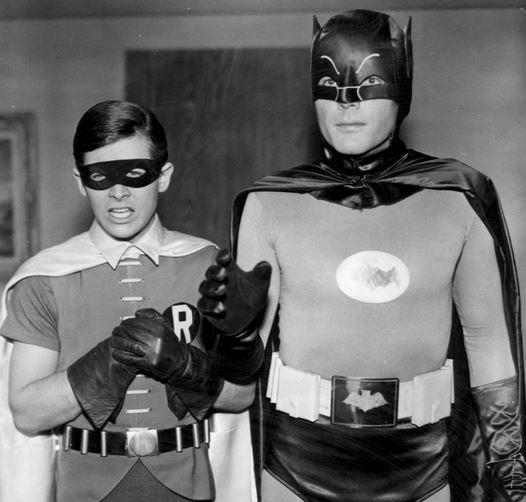
Credit: Thinkstock
Bam! Pow!
Everyone knows what that means: Superguys are slugging each other. And in this case, the "guy" is as important as the "super."
Yes, there's Buffy and Black Widow and (soon on film) Wonder Woman, but the superperson hitting the other superperson is more often male than not, and that's not exactly a coincidence. Males have long been the main creators and (this is changing, but still) main audience for superhero comics. The superbeing is most often a superman—and he hits things not just for justice, but as an expression of being a guy. To be a manly hero is to go Pow! And also Bam!
You can see the link between men, heroism, and Biff! very clearly at the point of Biff!'s origin. Those bam-pow sound effects come from the 1960s Batman television show, starring the inimitably campy Adam West. The show was finally released for the first time on DVD late last year, and my family has been cheerfully watching our way through its three seasons.
One of the main running gags is that only guys get to throw around those Sock! and Pow! sound effects. Typically, Batman and Robin fight a main costumed villain (the Riddler, the Joker, the Bookworm) who has a gang of two or more male thugs, with thematic appellations (like the Riddler's River Rat gang, composed of Whiskers, Fangs, and Whitey). In addition, there's usually a moll (Mousey, for the River Rat gang) dressed in something tight or clingy or revealing or (not infrequently) all three.
The dynamic duo fights the bad guys—but only the guys. The moll always stands off to the side, looking fetching and occasionally wincing elaborately in sympathy. Similarly, Julie Newmar's Catwoman, that felonious feline, never takes part in fisticuffs herself. Instead, she'll sometimes wait for the battle to end and her minions to be scattered about like so many sleeping Siamese before sashaying up and demurely scratching the victors with some of her patented catatonia.
Even Yvonne Craig's Batgirl, introduced in season three, didn't really get to mix it up. "Batgirl was not allowed to do any martial arts-type stuff," Craig reported. "The producer thought it wasn't ladylike." And so, Craig says, "I was (only) allowed to kick the bad guys in a sort of high-kick ballet manner." Girls can ballet, but punching is out.
Matt Yockey, in Batman: TV Milestone Series from last year, argues that women don't get to fight because Batman (and by implication the baseline superhero genre more generally) is sexist. He points to a third-season episode, in which an evil radical feminist succeeds in replacing all Gotham City's male police force with women. The new female officers are completely ineffectual; they do their make-up or talk about clothes when they should be fighting crime. Thus, corrupted by feminism, the city dissolves into chaos. You need men and super-patriarchy to maintain order. Pow!
That "pow!" though, might have some quotation marks around it. As Yockey says (and as anyone who has seen the show knows), "Batman" was parodic; its heroism, and its masculinity, were never served up straight. The fact that only guys get to fight isn't a vision of the way the world should be, necessarily. It's a joke about the way the superhero genre works. Batman and Robin don't drink anything stronger than wholesome milk; they never park the Batmobile in a no-parking zone without the permission of a duly appointed officer of the law; and, by the same logic, they don't hit women. Superguys are wholesome, representatives of a squeaky and preposterously clean patriarchy. Batman doesn't fight women for the same reason that Bruce Wayne tells Dick Grayson earnestly that he needs to practice his music lessons or his math or his foreign languages. That reason being that Batman is a corny Bat-doofus.
So was Batman in fact striking a blow (Kerwhap!) for feminism and against antiquated gender roles? Well, maybe not exactly. The show does maybe mock Batman's gallantry, but it also, as Yockey suggests, finds that gallantry appealing. Yes, a milk-drinking, bad-guy-bashing patriarch is silly—but he's also kind of attractive and comforting. Many of the molls fall for his dutiful nice guy charm, sidling up to his Bat paunch as steamy saxophones offer suggestions on the soundtrack. "I hereby remit myself to your muscular custody," Eartha Kitt's Catwoman purrs in season three. Again, the spectacle is a joke—but at the same time, Batman really was a massive pop icon, with adoring fans and (if Adam West's memoirs are any indication) substantial sexual opportunities. Traditional gender roles are dumb, but they're also seductive.
Which brings us back around to our current, seemingly endless parade of superhero films. Again, women in these films often do in fact get to fight; Anne Hathaway doesn't have to wait for the battle to end before her Catwoman does some damage. Captain Marvel and Wonder Woman films are on the horizon, in which superwoman will be the main stars, wearing tights and fighting for rights. But still, the question remains: Which rights are those, and whose? Does Scarlett Johansson kicking down bad guys in the name of law and order and Samuel Jackson really alter the superhero genre's dedication to the Man (super or otherwise)?
Those old Batman TV shows demonstrate that no matter how knowing you are, it's hard for superheroes to take the man out of Bam!
Images: Wikimedia Commons






